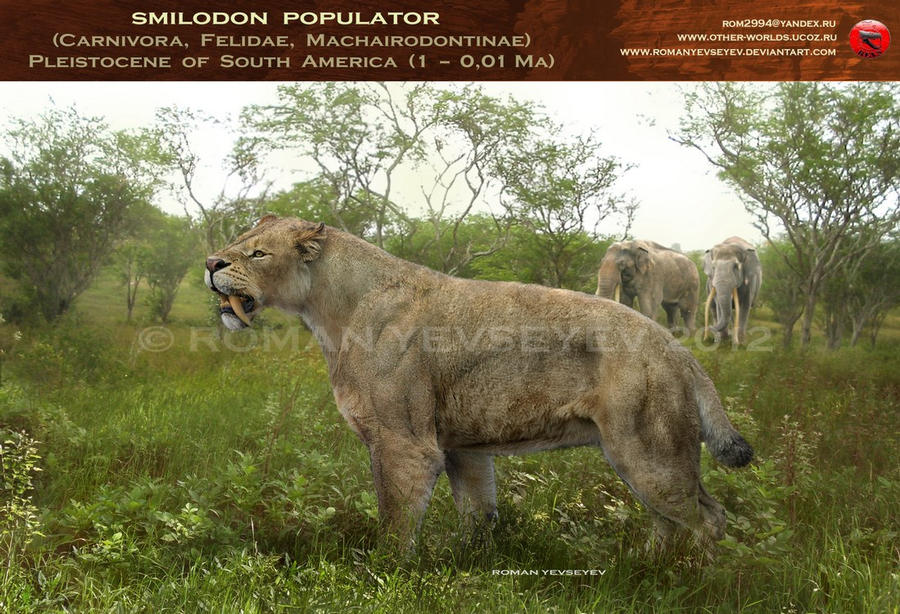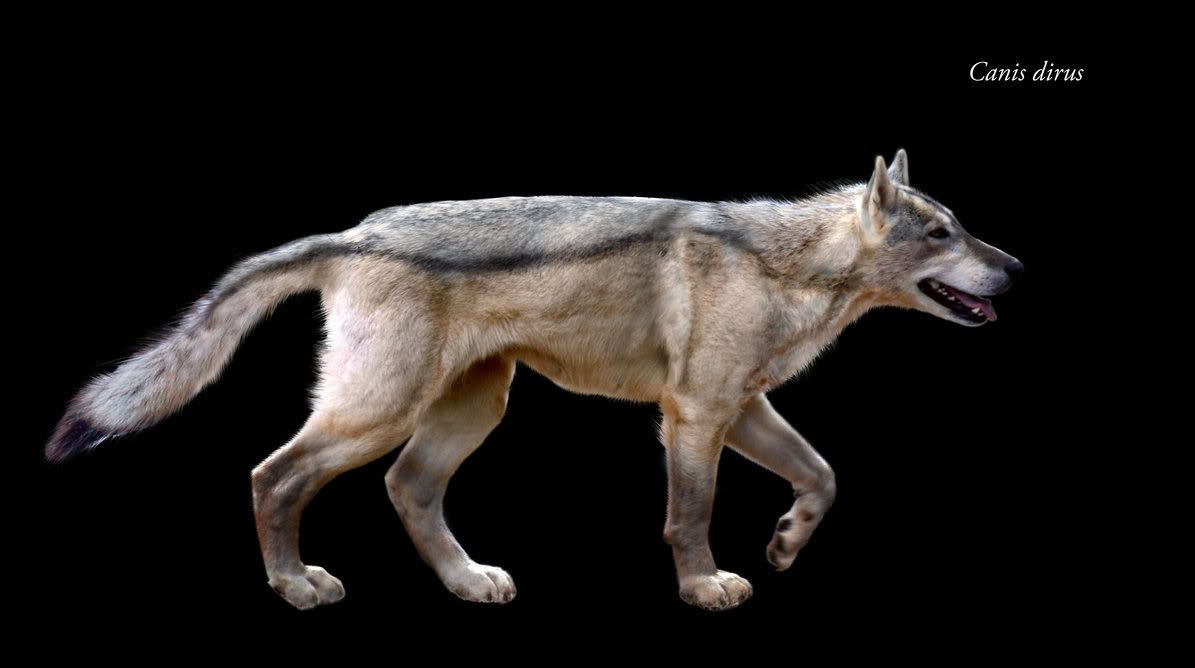Post by dinosauria101 on Mar 1, 2019 5:03:49 GMT 5
Smilodon populator
Smilodon, often called a saber-toothed cat or wrongly a saber-toothed tiger, is an extinct genus of machairodonts. This saber-toothed cat was endemic to North America and South America, living from near the beginning through the very end of the Pleistocene epoch (2.5 mya—10,000 years ago). Smilodon populator ("Smilodon the Devastator"), 1 million-10,000 years ago; occurred in the eastern parts of South America and was the largest species of all machairodonts. It was much larger than its cousins, S. fatalis and S. gracilis, possessing a massive chest and front legs, and is the largest known variety of saber-toothed cat. It was more than 1.40 m (55 in) high at the shoulder, 2.6 m (100 in) long on average and had a 30 cm (12 in) tail. Smilodon populator was substantially heavier and larger than any extant felid, with a body mass range of 220–360 kg. Particularly large specimens of S. populator almost certainly exceeded 400 kg in body mass. Its upper canines reached 30 cm (12 in) and protruded up to 17 cm (6.7 in) out of the upper jaw. Genetic evidence suggests that Smilodon populator and other members of the genus diverged from the main lineage of modern cats (subfamily Felinae) around 14-18 million years ago.

Dire Wolf (pack of 8) - Canis dirus
The Dire wolf (Canis dirus) is an extinct carnivorous mammal of the genus Canis, and was most common in North America and South America from the Irvingtonian stage to the Rancholabrean stage of the Pleistocene epoch living 1.80 Ma – 10,000 years ago, existing for approximately 1.79 million years. lthough it was closely related to the Gray Wolf and other sister species, Canis dirus was not the direct ancestor of any species known today. Unlike the Gray Wolf, which is of Eurasian origin, the Dire Wolf evolved on the North American continent, along with the Coyote. The Dire Wolf co-existed with the Gray Wolf in North America for about 100,000 years. The Dire Wolf was larger than the Gray Wolf, averaging about 1.5 metres (5 ft) in length and weighing between 50 kg (110 lb) and 79 kg (174 lb). Despite superficial similarities to the Gray Wolf, there were significant differences between the two species. The legs of the Dire Wolf were proportionally shorter and sturdier than those of the Gray Wolf, and its brain case was smaller than that of a similarly sized gray wolf. The Dire Wolf's teeth were similar to the Gray Wolf's, only slightly larger, pointing to a hypercarnivorous to mesocarnivorous activity. Paleontologist R.M. Nowak states the dietary characteristics are primarily carnivorous as well as partially omnivorous.

Credit to Wikipedia
Smilodon, often called a saber-toothed cat or wrongly a saber-toothed tiger, is an extinct genus of machairodonts. This saber-toothed cat was endemic to North America and South America, living from near the beginning through the very end of the Pleistocene epoch (2.5 mya—10,000 years ago). Smilodon populator ("Smilodon the Devastator"), 1 million-10,000 years ago; occurred in the eastern parts of South America and was the largest species of all machairodonts. It was much larger than its cousins, S. fatalis and S. gracilis, possessing a massive chest and front legs, and is the largest known variety of saber-toothed cat. It was more than 1.40 m (55 in) high at the shoulder, 2.6 m (100 in) long on average and had a 30 cm (12 in) tail. Smilodon populator was substantially heavier and larger than any extant felid, with a body mass range of 220–360 kg. Particularly large specimens of S. populator almost certainly exceeded 400 kg in body mass. Its upper canines reached 30 cm (12 in) and protruded up to 17 cm (6.7 in) out of the upper jaw. Genetic evidence suggests that Smilodon populator and other members of the genus diverged from the main lineage of modern cats (subfamily Felinae) around 14-18 million years ago.

Dire Wolf (pack of 8) - Canis dirus
The Dire wolf (Canis dirus) is an extinct carnivorous mammal of the genus Canis, and was most common in North America and South America from the Irvingtonian stage to the Rancholabrean stage of the Pleistocene epoch living 1.80 Ma – 10,000 years ago, existing for approximately 1.79 million years. lthough it was closely related to the Gray Wolf and other sister species, Canis dirus was not the direct ancestor of any species known today. Unlike the Gray Wolf, which is of Eurasian origin, the Dire Wolf evolved on the North American continent, along with the Coyote. The Dire Wolf co-existed with the Gray Wolf in North America for about 100,000 years. The Dire Wolf was larger than the Gray Wolf, averaging about 1.5 metres (5 ft) in length and weighing between 50 kg (110 lb) and 79 kg (174 lb). Despite superficial similarities to the Gray Wolf, there were significant differences between the two species. The legs of the Dire Wolf were proportionally shorter and sturdier than those of the Gray Wolf, and its brain case was smaller than that of a similarly sized gray wolf. The Dire Wolf's teeth were similar to the Gray Wolf's, only slightly larger, pointing to a hypercarnivorous to mesocarnivorous activity. Paleontologist R.M. Nowak states the dietary characteristics are primarily carnivorous as well as partially omnivorous.

Credit to Wikipedia




